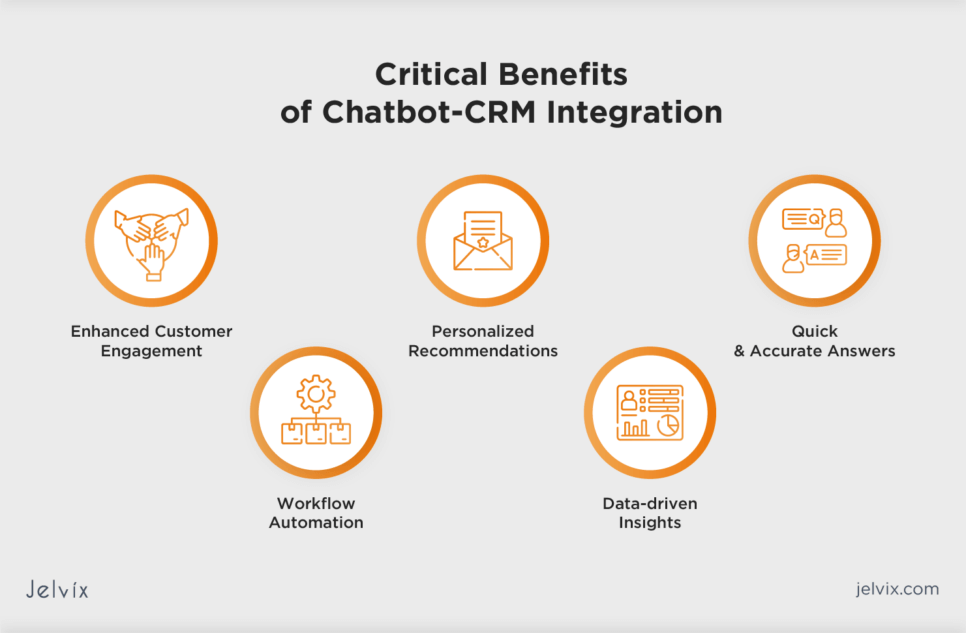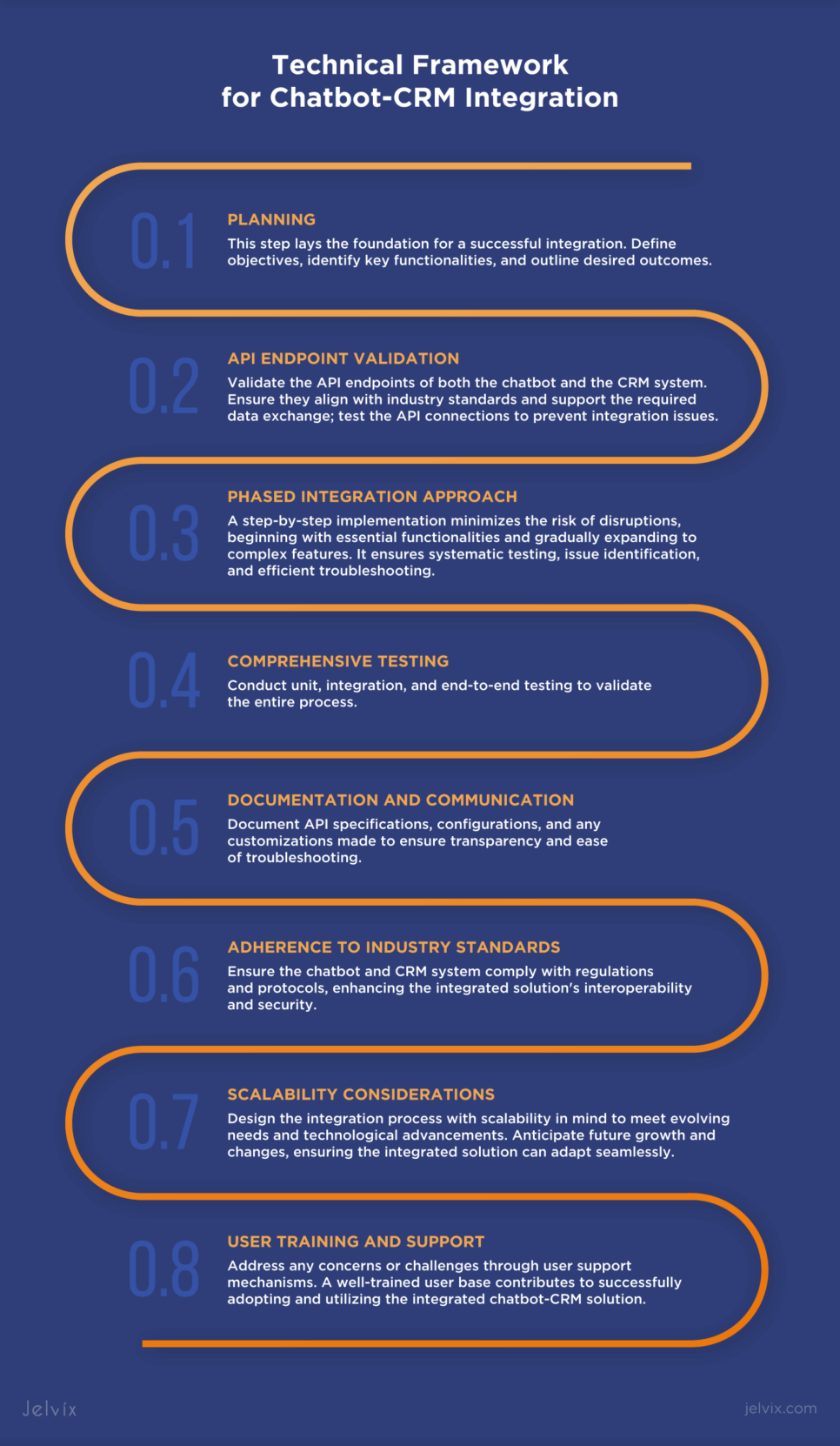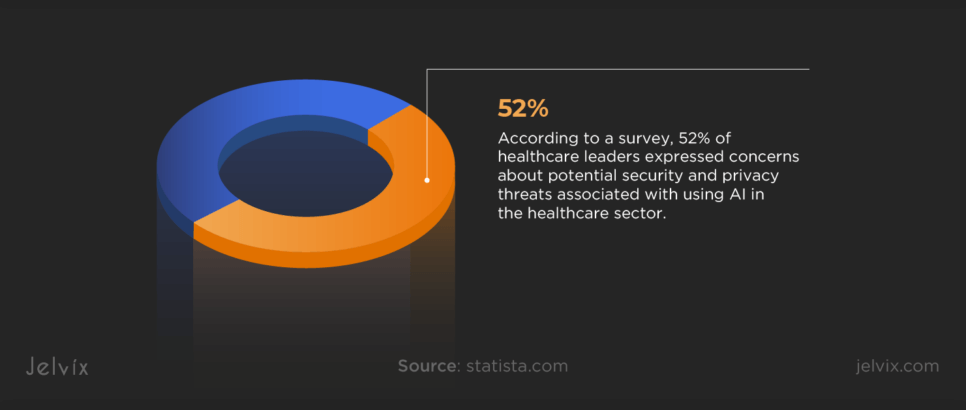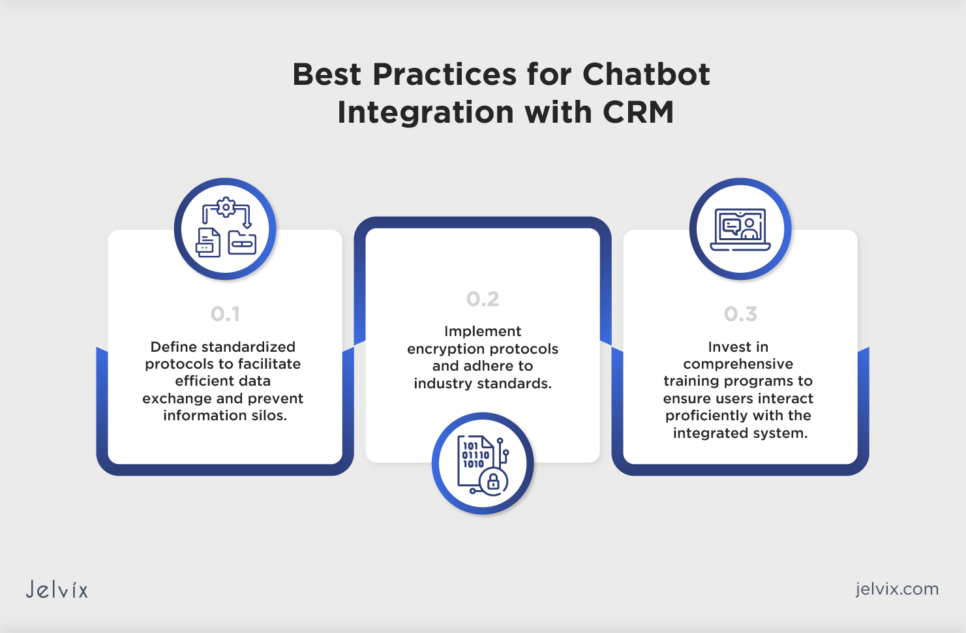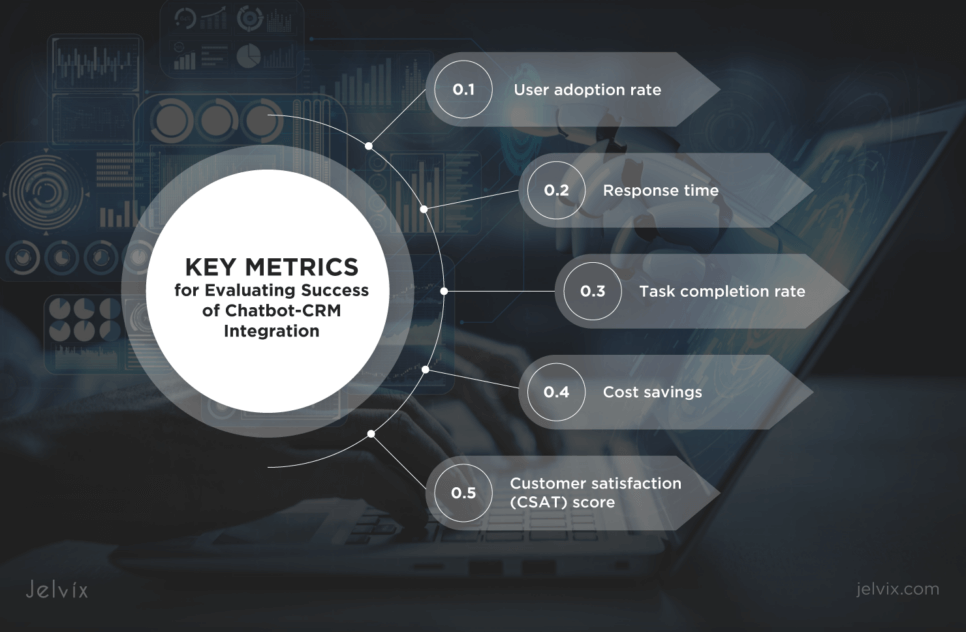The healthcare industry is changing rapidly, driven by technological advancements. Chatbots have become a key player in improving patient experiences. With advanced conversational AI, more inquiries are handled by chatbots, saving time for medical staff and potentially saving $3.7 billion in healthcare costs by 2023.
However, to allow truly enhanced patient interactions, chatbots should be seamlessly integrated with existing healthcare systems, including CRM.
If you aim to leverage healthcare outcomes with the help of tech solutions, keep reading. You will learn more about the benefits, challenges, and case studies related to CRM-chatbot integration, as well as ways to improve customer service efficiency while managing the complexities of this process.
Introduction to Chatbot-CRM Integration
Chatbots are intelligent virtual assistants designed to engage with users in natural language conversations. Their versatility spans from answering queries to guiding users through healthcare-related processes.
Customer Relationship Management (CRM) systems are the backbone of effective customer management. These platforms organize, analyze, and manage customer data, fostering personalized interactions and informed decision-making.
Integrated with a virtual assistant, CRM can enhance customer satisfaction and boost productivity. Such an integration is a strategic move that combines two powerful tools, enhancing customer interactions and organizational efficiency.
The Rationale Behind Integrating Chatbots with CRM
Integrating chatbots with CRM systems in healthcare strategically enhances patient engagement, allowing for seamless interactions, personalized healthcare experiences, efficient data utilization, and enhanced patient data management. Real-time access to customer data enhances the capabilities of chatbots, making interactions more efficient, personalized, and impactful.
Key Benefits of Chatbot-CRM Integration
The integration of chatbots with CRM systems brings numerous advantages that help healthcare organizations improve care delivery.
Enhanced Customer Engagement
Chatbot-CRM integration enhances customer engagement by providing instant 24/7 support. Customers can seamlessly transition from chatbot interactions to human agents while maintaining continuity in their inquiries.
Personalized Interactions
CRM data empowers chatbots to deliver personalized interactions. By tapping into customer history and preferences, chatbots can assist physicians in offering tailored recommendations, driving a more meaningful and personalized customer experience.
Quick and Accurate Answers
By connecting chatbots with CRM, they get instant access to the newest customer data. This means faster and more precise responses, as chatbots stay updated on customer interactions and transactions.
Workflow Automation
Chatbots integrated with CRM systems contribute to workflow automation. Routine tasks, such as data entry and appointment scheduling, can be automated, allowing human pros to focus on more complex and value-added activities.
Data-driven Insights
Chatbot-generated data and CRM analytics provide valuable insights into customer behavior and preferences. Organizations can leverage these insights to refine their strategies, improve service delivery, and enhance overall customer satisfaction.
Enhancing Customer Experience and Engagement
With their natural language processing capabilities, chatbots provide instant and personalized responses to customer queries. This fosters a seamless and interactive experience, making customers feel heard and valued.
Discover how developing a custom Healthcare CRM can enhance patient experience.
Streamlining Customer Service Processes
Chatbots handle routine inquiries, freeing up human specialists to focus on more important issues. This ensures quicker response times, improved resolution rates, and an overall efficient customer service operation.
Data Collection and Analysis for Personalized Care
Chatbots gather valuable customer information during interactions, which is then stored in the CRM. This data becomes a goldmine for personalized health delivery strategies. Physicians can use these insights to tailor treatment plans and recommend relevant medication.
Automation of Routine Tasks and Lead Generation
Chatbots handle repetitive tasks such as appointment scheduling, order tracking, and FAQ responses. They assist in lead generation by engaging with potential customers, capturing essential information, and seamlessly transferring qualified leads to the CRM. This automation accelerates the sales cycle and ensures that leads are efficiently managed.
Exploring the Technical Aspects of Integration
Integrating chatbots with CRM demands seamless connectivity and data synchronization. Application Programming Interfaces (APIs) play a key role in facilitating communication between a chatbot for healthcare and CRM. Robust security measures must be in place, too, to protect sensitive customer data. Additionally, customization options should be explored to tailor the integration to the specific needs and workflows of the business.
Overview of the Technical Framework for Integration
The technical framework for chatbot-CRM integration involves establishing compatibility between the chatbot and CRM systems. This includes addressing technical issues, ensuring smooth data flow, and implementing best practices for successful integration.
Compatibility Considerations between Chatbots and CRM Systems
Ensuring compatibility between chatbots and CRM systems requires evaluating technical specifications, data formats, and communication protocols. To foster effective information exchange, it’s crucial to implement standardized communication protocols and data formats.
Best Practices and Strategies for Successful Integration
Implementing integration best practices is essential for a successful collaboration between chatbots and CRM systems. A phased approach, starting with basic functionalities and gradually expanding, allows for efficient implementation and troubleshooting.
Planning
Before making efforts in chatbot-CRM integration, conduct comprehensive planning. Clearly define your objectives, identify key functionalities, and outline the desired outcomes. This initial step sets the foundation for a successful integration.
API Endpoint Validation
Validate the API endpoints of both the chatbot and CRM system. Ensure that they align with industry standards and support the required data exchange. Thoroughly test the API connections to prevent potential issues during integration.
Phased Integration Approach
Opt for a phased integration approach, starting with essential functionalities and gradually expanding to more complex features. This allows for systematic testing, identification of issues, and efficient troubleshooting. A step-by-step implementation minimizes the risk of disruptions.
Comprehensive Testing
Thorough testing is crucial to ensure the reliability and functionality of the integrated system. Conduct unit, integration, and end-to-end testing to validate the entire process. Promptly identify and address any discrepancies or malfunctions that may arise.
Documentation and Communication
Maintain clear documentation throughout the integration process. Document API specifications, configurations, and any customizations made to ensure transparency and ease of troubleshooting. Establish effective communication channels among the development team, stakeholders, and end-users.
Adherence to Industry Standards
Comply with industry standards and best practices for data exchange and security. Ensure that both the chatbot and CRM system adhere to relevant regulations and protocols. This commitment will help enhance the interoperability and security of the integrated solution.
Scalability Considerations
Design the integration process with scalability in mind to meet evolving business needs and technological advancements. Anticipate future growth and changes in requirements, and ensure that the integrated solution can adapt to change without disruptions.
User Training and Support
Provide comprehensive training for end-users. Address any concerns or challenges through user support mechanisms. A well-trained user base contributes to the successful adoption and utilization of the integrated chatbot-CRM solution.
By following these best practices and strategies, organizations can navigate the complexities of chatbot-CRM integration successfully.
Challenges of Chatbot-CRM Integration
Although the integration of chatbots with CRM brings numerous benefits to healthcare workflow, it also imposes challenges. These may include ensuring data synchronization, managing privacy and security concerns, and addressing potential bottlenecks in communication.
Data Synchronization Issues
Ensuring real-time synchronization of data between the chatbot and CRM system can lead to discrepancies and outdated information. Implement a robust data synchronization mechanism, utilizing reliable APIs and automated data update processes. Regularly monitor and reconcile data to maintain accuracy.
Security Concerns
Integrating chatbots with CRM systems requires stringent measures to safeguard patient information. Employ end-to-end encryption, secure APIs, and comply with healthcare data protection regulations. To address this challenge, regularly update security protocols and conduct security audits.
Compatibility Issues
Incompatibility between the chatbot platform and CRM system may arise due to differences in technologies, versions, or data structures. Prioritize platforms with compatible technologies and versions. Invest in middleware solutions if necessary to ensure seamless communication between the chatbot and CRM.
User Adoption Challenges
Healthcare staff and end-users may need help adapting to the integrated system. Neglecting this need may lead to resistance to the use of the new solution. Provide extensive training sessions, create user-friendly interfaces, and offer ongoing support to the users.
Scalability Concerns
As the healthcare organization grows, scalability challenges may arise, affecting the performance of the integrated system. Ensure scalability by designing the integration with cloud-based solutions and adaptable architectures. Regularly assess and upgrade infrastructure to accommodate ongoing growth.
Workflow Disruptions
Poorly managed integration can lead to disruptions in existing workflows, impacting daily operations and patient care. Implement a phased integration approach, starting with non-disruptive functionalities. Engage stakeholders throughout the process, addressing concerns and refining workflows collaboratively.
Technical Hurdles and Compatibility Issues
Technical hurdles and compatibility issues in chatbot-CRM integration refer to challenges arising from the diverse technologies and structures of these systems. This includes differences in data formats, communication protocols, or programming languages that limit information exchange.
Maintaining Data Privacy and Security
According to a survey, 52% of healthcare leaders expressed concerns about potential security and privacy threats associated with the use of AI in the sector. Healthcare organizations must prioritize safety by implementing robust encryption, access controls, and secure communication channels. Adhering to data protection regulations and conducting regular security audits is crucial for upholding user data integrity and confidentiality.
Addressing the Limitations of Chatbot Intelligence
Chatbots may have limitations in understanding complex queries or providing nuanced responses. Overcoming these limitations requires improvement in natural language processing capabilities, training the chatbot with diverse datasets, and incorporating machine learning advancements. Striking a balance between automated responses and human intervention ensures an effective and reliable user experience.
Real-World Examples of Successful Chatbot-CRM Integrations
In 2021, the global healthcare chatbots market was worth $184.60 million, and it’s expected to reach $431.47 million by 2028. It means more companies around the globe are adopting chatbots into their medical workflows and integrating them with existing systems, including CRMs.
AVAAMO
AVAAMO seamlessly integrates its voice AI technology into the CRM system of Epic, a prominent healthcare records giant. AVAAMO’s voice AI powers multiple tools, aiding patients in healthcare navigation, doctor searches, procedure information, and managing appointments and tasks like insurance updates, retrieval of test results, and initial registration of users into Epic’s system.
Cerner Corporation
Cerner Corp. collaborates with Amazon Web Services Inc. to integrate chatbots into its systems, leveraging AWS as its primary provider for cloud, AI, and machine learning. This involves creating chatbots that use machine learning to retrieve patient information from health records and address medical queries. Furthermore, Cerner aims to automate doctors’ clerical tasks using AWS machine learning services like Amazon Transcribe Medical to relieve physicians from note-taking duties.
Philips
Philips teamed up with MedChat to integrate live chat and AI-driven chatbot services into their Patient Navigation Manager. This collaboration streamlines patient requests and enhances call center efficiency, allowing North American healthcare providers to create automated communication workflows. Patients benefit from seamless interactions with chatbots and live agents, powered by natural language processing and machine learning algorithms from MedChat.
Lessons Learned and Best Practices
While browsing through chatbot and CRM-EHR Integration case studies, the Jelvix team learned best practices that provide valuable insights for healthcare organizations aiming to integrate chatbots with CRM systems. Implementing these strategies can contribute to enhanced patient care and a seamless healthcare experience.
Clear Communication Channels
Establishing transparent communication between chatbots and CRM systems is essential for seamless integration. Define standardized protocols to facilitate efficient data exchange and prevent information silos.
Data Privacy and Security
Prioritize robust measures to uphold data privacy and security. Implement encryption protocols and adhere to industry standards, such as HIPAA, to safeguard sensitive information exchanged during integration.
User Training and Adoption
Invest in comprehensive training programs to ensure users, including staff and customers, are proficient in interacting with the integrated system. Adoption strategies should focus on creating a seamless user experience.
AI Intelligence Enhancement
Regularly enhance AI capabilities to keep pace with evolving technologies. Continuous improvement ensures that chatbots can provide accurate and relevant responses, contributing to user satisfaction.
Realistic Expectations
Set realistic expectations regarding the capabilities and limitations of chatbot-CRM integration. Understanding the scope of the integration helps in managing expectations and achieving successful outcomes.
Emerging Technologies Enhancing Chatbot-CRM Integration
As healthcare tech advances, chatbot-CRM integration is enhanced with advanced NLP, machine learning, predictive analytics, voice recognition, wearable device compatibility, and multi-channel integration, ensuring a seamless user experience across various platforms.
Predictions for Future Developments in AI and CRM
Looking ahead, the following predictions outline the potential developments in AI and CRM integration:
- Enhanced personalization: future developments will focus on achieving hyper-personalization by leveraging AI to understand individual preferences, behaviors, and health history. This will result in more tailored and relevant interactions;
- Augmented intelligence: the convergence of AI in CRM will lead to the concept of augmented intelligence, where AI systems will work collaboratively with healthcare professionals to enhance decision-making and patient care outcomes;
- IoT integration: as the Internet of Things continues to expand in healthcare, CRM systems will integrate seamlessly with various IoT devices. This will allow for real-time monitoring of patients’ vital signs and health metrics, enabling quicker responses to critical situations;
- Predictive healthcare analytics: future developments will emphasize the integration of predictive healthcare analytics into CRM systems, allowing organizations to anticipate trends, identify potential health risks, and proactively address patient needs. Predictive analytics will play a pivotal role in preventive care strategies.
Strategies for Successful Implementation
Successful implementation of chatbot-CRM integration requires careful consideration of the following strategies:
- User-centric design: prioritize user-centric design principles to ensure that the integrated system aligns with the needs and preferences of both healthcare professionals and patients;
- Continuous training and education: implement ongoing training programs to keep healthcare professionals updated on the capabilities of integrated systems;
- Scalability and flexibility: choose technologies that offer scalability and flexibility to accommodate future advancements and changing healthcare requirements;
- Regulatory compliance: ensure strict adherence to healthcare regulations and data privacy standards to maintain the security of patient information;
- Cross-functional collaboration: foster collaboration between IT, healthcare, and administrative teams for diverse perspectives and successful implementation of chatbot-CRM integration.
Steps To Integrate a Chatbot with a CRM System
Successfully integrating chatbots with CRM systems requires a systematic approach. Follow this step-by-step guide for a smooth integration process:
- Define integration objectives: clearly outline the objectives and goals of the integration. Identify the specific tasks and processes that chatbots will handle within the CRM system.
- Assess CRM compatibility: evaluate the compatibility of your CRM system with chatbot technology. Ensure that the CRM platform supports the required APIs and data exchange mechanisms for seamless integration.
- Choose the right chatbot: select a chatbot platform that aligns with your integration goals. Consider factors such as natural language processing capabilities, scalability, and customization options.
- Design a conversational CRM: map out the conversation flows that the chatbot will engage in within the CRM environment. Define user interactions, data inputs, and integration points with CRM functionalities.
- Configure API connections: establish robust API connections between the chatbot platform and the CRM system. Configure data endpoints, authentication mechanisms, and error-handling processes for reliable data exchange.
- Train the chatbot: train the chatbot to understand context-specific queries and respond accurately within the CRM context. Provide sufficient data for machine learning algorithms to enhance the chatbot’s performance.
- Implement data security measures: prioritize data security by implementing encryption protocols and access controls. Ensure that sensitive information exchanged between chatbots and CRM systems is protected.
- Conduct testing phases: perform testing at each integration phase. Test the chatbot’s interactions within the CRM, data accuracy, and real-time synchronization. Address any issues identified during testing.
- Monitor and optimize: implement monitoring tools to track the chatbot’s post-integration performance. Monitor user interactions, system response times, and data accuracy. Continuously optimize the integration based on feedback and performance metrics.
Key Metrics and KPIs for Evaluating Success
Evaluating the success of chatbot-CRM integration involves tracking various metrics and key performance indicators (KPIs) to measure the impact and effectiveness of the implemented solution. The most common metrics include:
- User adoption rate: measure the percentage of users who actively engage with the integrated system. This indicates how well the solution is accepted by users;
- Response time: evaluate the time it takes for the chatbot to respond to user inquiries. A shorter response time often correlates with improved user experience;
- Task completion rate: assess the percentage of tasks or inquiries successfully completed by the chatbot. A higher completion rate signifies effectiveness;
- Cost savings: analyze the cost-effectiveness of the integration by comparing the expenses associated with the solution against potential savings in operational costs;
- Customer satisfaction (CSAT) score: collect feedback from users to measure their satisfaction with the integrated system. A higher CSAT score indicates positive user experiences.
By regularly monitoring these metrics, organizations can gain a comprehensive understanding of the integration’s performance, identify areas for improvement, and make data-driven decisions to maximize the benefits of chatbot-CRM integration.
Measuring ROI of Integration
Evaluating the Return on Investment in integration involves assessing financial gains versus incurred costs. Healthcare providers should quantify all integration costs, such as development, hardware, training, and maintenance, comparing them with cumulative benefits to determine overall profitability.
Final Thoughts: How Jelvix Can Assist in CRM-Chatbot Integration
Chatbot-CRM integration in healthcare represents a transformative step towards enhancing patient experiences, optimizing data management, and streamlining engagement.
As an experienced tech partner, we, at Jelvix, understand the essential role that integration plays in revolutionizing healthcare practices. We follow proven processes for comprehensive chatbot development and offer reliable solutions that allow integrating AI into CRM systems.
If you seek proven ways to innovate and improve customer interaction and data management through technology, reach out to our managers. Let’s discuss your needs and ways to cover them.
Explore seamless data exchange between chatbots and CRM systems with Jelvix—optimize customer relationship management through Chatbot-CRM integration.



